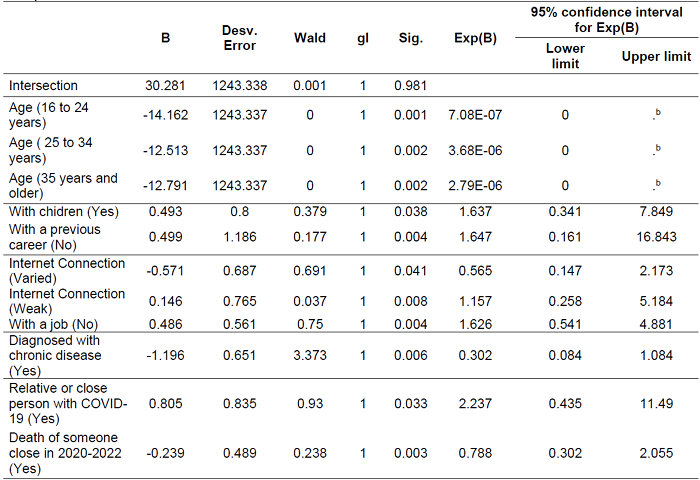Meu SciELO
Serviços Personalizados
Journal
Artigo
Indicadores
-
 Citado por SciELO
Citado por SciELO -
 Acessos
Acessos
Links relacionados
-
 Citado por Google
Citado por Google -
 Similares em
SciELO
Similares em
SciELO -
 Similares em Google
Similares em Google
Compartilhar
Enfermería Global
versão On-line ISSN 1695-6141
Enferm. glob. vol.22 no.71 Murcia Jul. 2023 Epub 13-Nov-2023
https://dx.doi.org/10.6018/eglobal.553991
Originals
Characteristics associated with depression, anxiety, and stress in university students
1Professor of the Formative Research Program of the César Vallejo University. Trujillo, Peru
2Professor of the Formative Research Program at the César Vallejo University. Chepén, Peru
3Professor of the Formative Research Program at the César Vallejo University. Chimbote, Peru
4Professor at the Research Institute of the César Vallejo University. Trujillo, Peru
Introduction:
The present research focused on analyzing the characteristics associated with depression, anxiety and stress in university students in times of COVID-19 pandemic.
Method:
The study had a non-experimental, correlational, prospective, cross-sectional design. The data collection technique was the survey, and its instrument was the DASS-21 questionnaire, which has a very good reliability of 0.91. It has been applied virtually to 385 Peruvian university students.
Results:
The results show that 12% of the students surveyed presented high stress, 7% severe anxiety and 9% severe depression. Among the factors associated with stress were age, previous major, having a job, having a chronic disease. Anxiety had associated factors such as age, having a previous career, work status and diagnosis of a chronic disease. Depression was associated with factors such as age, having children, having a previous major, internet connection, having a job, having been diagnosed with a chronic disease, having a family member or a close person with COVID-19, and finally having someone close who had passed away.
Conclusion:
Three logistic regression models were estimated with 77.3%, 68.2% and 63.3% certainty for stress, anxiety and depression, respectively.
Keywords: Depression; anxiety; stress; Covid-19
INTRODUCTION
The World Health Organization declared the outbreak of the SARS COV-2 virus (Covid-19) as a pandemic on March 11, 2020, just a week before it had already reached Peru with its first infection (1). The whole world was informed about the high potential for contagion and spread of this virus, which quickly spread to 114 countries, with 118,000 infections and 4,291 fatalities (2). This represented a public health emergency with consequences in all political, social, economic and, above all, health fields, not only because of the human losses (3), but also because of the psychosocial disorders, stress, anxiety, depression, at the individual and collective levels, due to the prolonged quarantines and isolation to which we were subjected.
It has been verified that quarantine greatly reduces the physical activity of individuals even compared to situations of incarceration (4).
In this context, in Peru, educational institutions at all levels decided to suspend classroom activities for a period of 15 days (5). However, this measure was extended as a result of the increase in the number of infections and mutations of the Covid-19 virus (6). In the university field, the remote teaching modality implied not only the development of strategies for the implementation of virtual education, but also the adaptation of teachers to this new modality with the objective of achieving quality and continuity in the studies of young people, redesigning and learning to handle new digital platforms and adapting them to the contents (7).
In addition, the students had to face several inconveniences in the economic aspect, their own illness and psychological conditions such as depression and anxiety, which are considered as a psychic discomfort in dangerous situations (8). Anxiety is known to influence the success or failure of students' actions (9). Likewise, stress occurs in both positive and negative experiences. Faced with these stressors, the organism can generate two types of reactions, one of which is to avoid the stressful situation both physically and psychologically, and the other reaction is to confront the stressor with the resources one has to overcome it, triggering a whole response that prepares one for a real defense against aggression, either present or future (10).
For this reason, it is considered that research on anxiety, depression and stress is of utmost importance. Studies conducted in Asian countries, only on anxiety, reported a prevalence of over 20%, with differences in occupation and gender, being the student population the most affected (11) and having among the main consequences the critical psychological impact that generates uncertainty (12) and which is related to the decrease of interpersonal skills (13).
Regarding the deterioration of mental health, there was evidence of an increase in moderate-severe levels of depression, anxiety and stress, and even, in some cases, there was suicidal ideation as well as suicidal intention (14).
At the international level, several studies have been carried out on university students. In Mexico, 53.2% presented anxiety problems, 47.8% presented stress, and 29% showed some disorder associated with depression, which was reflected in their academic performance (15). In Cuba, 63.11% of students had excessive stress, 56.8% pathological stress, 54.85% medium depression, and 57.69% of those with excessive stress had medium depression as well. The high levels of stress caused these students to show depressive behaviors. The complex curriculum and, adding to this, the pandemic produced by COVID-19 was what led to a significant presence of stress levels, directly affecting their mood and their desire to be able to continue with their studies (16). In Turkey, 13.63% of the participants showed anxiety and 52.55% had a medium level of stress; a significant association in gender, loss of a family member and year of study, all related to COVID-19(17). In Greece, the prevalence of anxiety and depression was found to be 35.8% and 51.2%, respectively. Factors associated with this prevalence were school, financial situation, health status, level of satisfaction with state response, university and daily routine (18). The correlations among these dimensions were also strong in relation to health, demographics and lifestyle, and for the other variables their values predicted depression, anxiety and stress (19).
In Peru, research on factors associated with depression, anxiety and stress in the context of the Covid-19 pandemic applied to Lima police officers found prevalence of 11.43%, 10% and 7.62%, respectively, where anxiety was associated with the number of children (p:0.032) and comorbidities (p:0.031). Likewise, in the multivariate analysis, depression and age were associated (p:0.044), stress and sentimental situation (p:0.034), diagnosis of Covid-19 (p:0.045) and comorbidities (p:0.022); It was concluded that the risk factors for stress were being single, diagnosed with Covid-19 and comorbidities, while the risk factor for depression was being under 40 years of age(20). Similarly, another study found that the frequencies of depression, anxiety and stress in human medical students were 24.3%, 28.5% and 13.0%, respectively. Likewise, it was found that the highest frequency of anxiety was associated with being Catholic, having a shorter year of study or having a chronic disease, while the highest frequency of stress was associated with being younger (21).
Based on the aforementioned, the purpose of this research is to analyze the characteristics associated with depression, anxiety and stress in university students during the COVID-19 pandemic.
MATERIAL AND METHOD
A descriptive study, with a quantitative approach, correlational, prospective, cross-sectional scope, in order to analyze the study variables and apply the instrument at a certain point in time (22).
(M------------O); where M is the sample and O, the observation of interest collected from the sample.
The population consisted of all university students in the department of La Libertad with Internet access. The surveys were conducted online because the social isolation decreed by the Peruvian government was still in force. The convenience sampling, selecting a sample of 385 students, was calculated by applying the formula for unknown population, using a prevalence of 50%, confidence level of 95%, and an adjusted error of 5% (23). The inclusion criteria included students from the first to the tenth cycle who were enrolled and in attendance on a regular basis at the universities in the department of La Libertad and who consented to participate voluntarily in the study.
The technique used for data collection was the survey and as an instrument a questionnaire of closed questions, which was answered virtually, making publications through social networks (WhatsApp, Facebook) and e-mail (23). The questionnaire was the DASS-21 scale, created by Lovibond and Lovibond in 1995(24) and later adapted by Román et al., (25) who determined its psychometric properties and accepTable factorial in almost all indexes (26),(27) in order to measure stress, anxiety and depression independently. It is made up of 21 questions: with 7 closed items for each dimension respectively, which will help to measure the variables and satisfactorily resolve the general objective of interest through statistical procedures.
The biological characteristics considered are age and sex; social characteristics: if he/she has a partner, has completed a previous professional career, lives alone, works, marital status, study cycle, and type of religion; characteristics related to health: if he/she has a diagnosis of a chronic disease, has a close friend or relative diagnosed with COVID 19, and if a close relative died in 2021.
For the analysis of the information, the SPSS version 26 statistical package was applied, using descriptive statistics such as percentages, calculation of averages, mode, standard deviation and statistical graphs. Kendal's tau b statistic was also calculated to identify the factors associated with anxiety, depression and stress, as well as the estimation of a logistic regression model (28).
The Helsinki declaration was taken into account, respecting the decision of the students to participate or not in the study by means of the informed consent letter where all of them established and accepted the limits of their participation, complying with the principle of autonomy. The authors maintained the integrity of the participants without jeopardizing the information obtained (confidentiality of the data) in compliance with the principle of maleficence, and the information obtained was distributed equally without any discrimination, in compliance with the principle of justice (29).
RESULTS
Table 1: Relationship between factors and stress in university students during the COVID-19 pandemic.
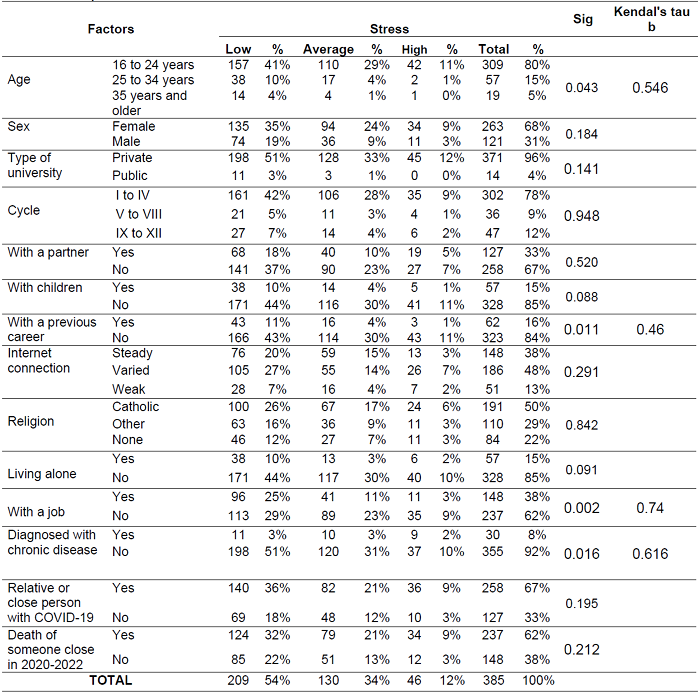
Note:Data obtained from the sample
Table 2: Selection of factors associated with stress in university students during the COVID-19 pandemic.
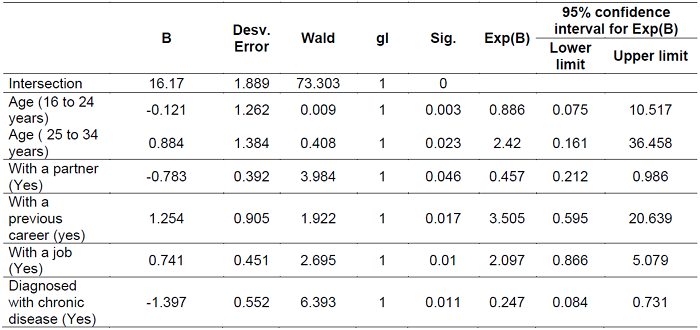
*77.3% of model accuracy
Note:Data obtained from the sample
Table 3: Relationship between factors and anxiety in university students during the COVID-19 pandemic.
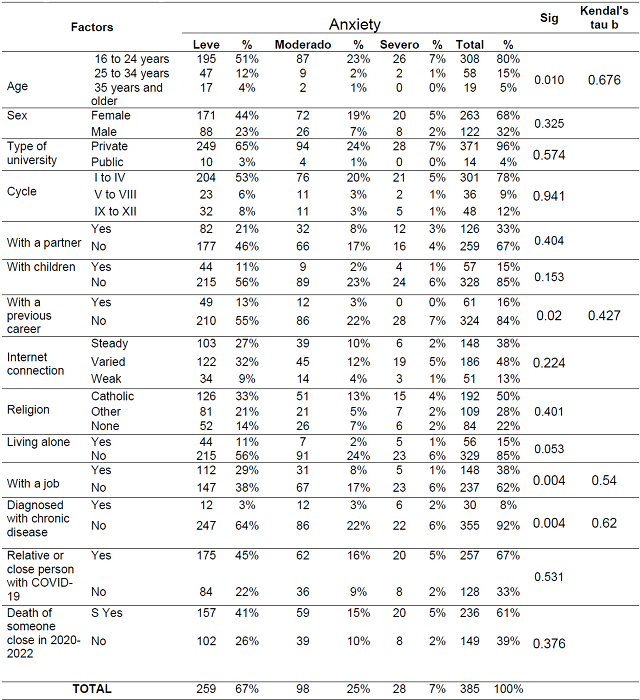
Note:Data obtained from the sample
Table 4: Selection of predictors of anxiety in university students during the COVID-19 pandemic.
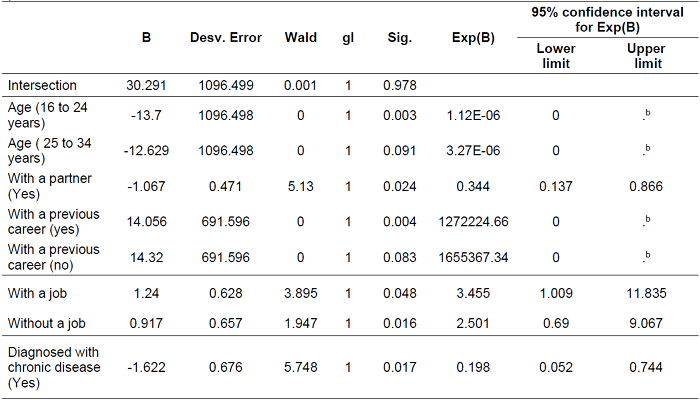
*68.2% of model accuracy
Table 5: Factors associated with depression in university students during the COVID-19 pandemic.
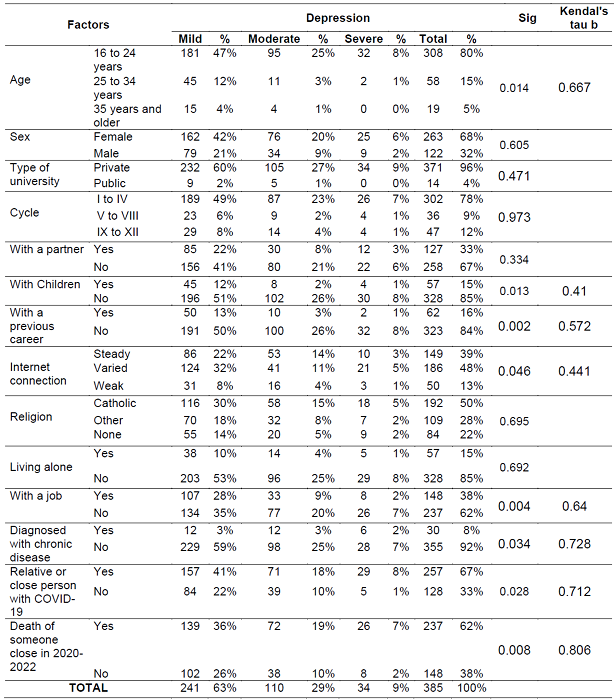
Note:Data obtained from the sample
DISCUSSION
The data collected in the research show that the majority of young university students present low stress. However, there are 12% with high stress, as shown in Table 1. The changes that occurred in the pandemic brought as a consequence alteration in the emotional state of young university students, coinciding with what is indicated by a study that states that the changes in our organism originate in response to certain factors that may occur in reality (30). However, the result also presents differences with other investigations in which 52.55% of the students showed a medium level of stress and 63.11% presented an excessive level of stress related to the pandemic (16),(17), respectively. However, given that the data collection was conducted in 2022, the fact that the stress was mostly low may be attributed to the omission of certain restrictions established by the national government to curb the pandemic, as compared to 2020 and 2021. On the other hand, our results identified that younger students aged 16 to 24 years showed the highest percentage of stress (11%), which coincides with Sandoval et al where it was found that the highest frequency of stress is associated with being younger (21).
Table 2 showed that the logistic regression model included as associated variables and predictors of stress, being aged between 16 and 34 years, having a partner, previous career, having a job and being diagnosed with a disease, (p<0.05), which coincides with a study in Peru where factors such as years of study or chronic diseases presented average levels of stress and anxiety (21).
Table 3 shows that most of them present a slight level of anxiety, but in the analysis of the related factors it was found that age, having a previous career, work status, diagnosis of a chronic disease are significantly related (p < 0.05) to anxiety, aspects that coincide with the research of Sasal et al. where, in addition, anxiety and stress due to studies were also related (18).
The logistic regression model shown in Table 4 has determined the factors that are related and are predictors for anxiety, and the following were found, being aged between 25 to 34 years, with or without previous career, with job, diagnosed with chronic disease. Likewise, Trunce et al., state that the perceived state of health or the presence of a chronic disease in students is among the factors associated with this prevalence, which also triggers low performance (15).
When identifying the factors that are related to depression in Table 5, we found age, having children, having a previous career, internet connection, having a job, having been diagnosed with a chronic disease, having a family member or close person with COVID-19 and, finally, having someone close who had died (p<0.05). This affects the normal development of their life, lowers their mood, and gives them a sense of guilt. Sazakli and team also showed risk results for depression (18). In turn, Cobiellas presented average results in depression generated by high levels of stress (16).
When identifying the predictors of depression in Table 6, it was also determined the categories that are related to this anomaly in university students by obtaining a significance value (p value) of less than 5%; these were: 16 years of age or older, having children, not having a previous career, having a varied to weak Internet connection, not having a current job, having been diagnosed with a chronic disease, having a family member or close person with COVID, and having someone close who had died (p<0.05). These aspects coincide with studies where it was found that students who lost a family member had a significant relationship with anxiety and stress (16),(17). Hamaideh et al., mention that during quarantine a high level of depression prevailed and consider that these factors can predict anxiety, depression and stress in students (19).
The main limitation in this study was the access to information by the students, since we are in a state of health emergency, the sampling technique used was by convenience. However, the estimated logistic regression models obtained good prognostic percentages.
The information obtained is of great importance since it helps us to make decisions to avoid mental health diseases in our university students. Therefore, it is recommended to university authorities, the implementation of workshops to master stress, anxiety, depression, as well as consultations by the specialized professional to treat this type of problems.
CONCLUSIONS
The results allow us to conclude that the estimated logistic regression models indicate the characteristics associated with stress, anxiety and depression, which had a good percentage of certainty with 77.35, 68.2% and 63.3% respectively, where the factors of age, having a job and having been diagnosed with a chronic disease are common to the models analyzed. In addition, it can be seen that the majority of university students presented a low level of stress. However, there are still 12% of them with high stress who require support and attention. In addition to the above, the depression variable increases with the factor of having children, not having a previous career and that a relative had passed away.
REFERENCIAS
1. Organización Mundial de la Salud. Depresión [Internet]. 2021. Available from: https://www.who.int/es/news-room/fact-sheets/detail/depression [ Links ]
2. UNAM Global. El escenario adverso de la pandemia COVID-19 y la oportunidad de construir una comunidad resiliente [Internet]. 2020 [cited 2023 Jan 11]. Available from: https://unamglobal.unam.mx/el-escenario-adverso-de-la-pandemia-covid-19-y-la-oportunidad-de-construir-una-comunidad-resiliente/ [ Links ]
3. Ministerio de Salud. Sala de Situacion de Covid [Internet]. Sala Covid. Lima - Perú; 2022 [cited 2023 Jan 11]. Available from: https://www.dge.gob.pe/covid19.html [ Links ]
4. Pecanha T, Goessler KF, Roschel H, Gualano B. Social isolation during the COVID-19 pandemic can increase physical inactivity and the global burden of cardiovascular disease [Internet]. Vol. 318, American Journal of Physiology - Heart and Circulatory Physiology. American Physiological Society; 2020 [cited 2023 Jan 11]. p. H1441-6. Available from: https://journals.physiology.org/doi/10.1152/ajpheart.00268.2020 [ Links ]
5. Decreto Supremo No 044-2020-PCM. Decreto Supremo que declara Estado de Emergencia Nacional por las graves circunstancias que afectan la vida de la Nación a consecuencia del brote del COVID-19. D Of El Peru [Internet]. 2020 Oct 22 [cited 2023 Jan 11];(90):545318-21. Available from: https://busquedas.elperuano.pe/normaslegales/decreto-supremo-que-declara-estado-de-emergencia-nacional-po-decreto-supremo-n-044-2020-pcm-1864948-2/ [ Links ]
6. Vilela Alemán P, Sánchez Claderón JE, Chau C. Desafíos de la educación superior en el Perú durante la pandemia por la COVID-19. Desde el Sur [Internet]. 2021 Sep 13 [cited 2023 Jan 11];13(2):e0016. Available from: https://revistas.cientifica.edu.pe/index.php/desdeelsur/article/view/867 [ Links ]
7. Canaza-Choque FA. Educación superior en la cuarentena global: disrupciones y transiciones. Rev Digit Investig en Docencia Univ [Internet]. 2020 Dec 18 [cited 2023 Jan 11];14(2):e1315-e1315. Available from: https://revistas.upc.edu.pe/index.php/docencia/article/view/1315 [ Links ]
8. Sierra JC, Ortega V. Ansiedad, angustia y estrés: tres conceptos a diferenciar Ihab Zubeidat. Rev Mal-estar E Subjetividade [Internet]. 2018 [cited 2023 Jan 11];10(4):10-59. Available from: https://www.redalyc.org/pdf/271/27130102.pdf [ Links ]
9. Taylor S. The psychology of pandemics: Preparing for the next global outbreak of infectious disease. Cambridge Scholars Publishing.; 2019. [ Links ]
10. Barrio JA, García MR, Ruiz I, Arce A. EL ESTRÉS COMO RESPUESTA. Int J Dev Educ Psychol [Internet]. 2006 [cited 2023 Jan 11];1(1):37-48. Available from: https://www.redalyc.org/articulo.oa?id=349832311003 [ Links ]
11. Pappa S, Ntella V, Giannakas T, Giannakoulis VG, Papoutsi E, Katsaounou P. Prevalence of depression, anxiety, and insomnia among healthcare workers during the COVID-19 pandemic: A systematic review and meta-analysis [Internet]. Vol. 88, Brain, Behavior, and Immunity. Academic Press Inc.; 2020 [cited 2023 Jan 11]. p. 901-7. Available from: https://doi.org/10.1016/j.bbi.2020.05.026 [ Links ]
12. Bao Y, Sun Y, Meng S, Shi J, Lu L. 2019-nCoV epidemic: address mental health care to empower society [Internet]. Vol. 395, The Lancet. Lancet Publishing Group; 2020 [cited 2023 Jan 11]. p. e37-8. Available from: https://doi.org/10.1016/%0AS0140-6736(20)30309-3%0A [ Links ]
13. Xiao C. A novel approach of consultation on 2019 novel coronavirus (COVID-19)-related psychological and mental problems: Structured letter therapy [Internet]. Vol. 17, Psychiatry Investigation. Korean Neuropsychiatric Association; 2020 [cited 2023 Jan 11]. p. 175-6. Available from: https://doi.org/10.30773/pi.2020.0047 [ Links ]
14. Mejia CR, Solis-Cristobal E, Vilchez ZC, Vera-Gonzales JJ, Arias-Chávez D, Vinelli-Arzubiaga D, et al. Impact on the mental health of undergraduate students and their parents at the onset of the COVID-19 pandemic. Bol Malariol y Salud Ambient [Internet]. 2021 Aug 16 [cited 2023 Jan 11];61(0):106-13. Available from: http://iaes.edu.ve/iaespro/ojs/index.php/bmsa/article/view/315 [ Links ]
15. Trunce Morales ST, Villarroel Quinchael G del P, Arntz Vera JA, Muñoz Muñoz SI, Werner Contreras KM. Niveles de depresión, ansiedad, estrés y su relación con el rendimiento académico en estudiantes universitarios. Investig en Educ Médica [Internet]. 2020 [cited 2023 Jan 11];9(36):8-16. Available from: https://doi.org/10.22201/fm.20075057e.2020.36.20229 [ Links ]
16. Cobiellas Carballo LI, Anazco Hernández A, Gongora Gómez O. Estrés académico y depresión mental en estudiantes de primer año de medicina. Rev Cuba Educ Medica Super [Internet]. 2020 Jun 16 [cited 2023 Jan 11];34(2). Available from: https://ems.sld.cu/index.php/ems/article/view/2125 [ Links ]
17. Durbas A, Karaman H, Solman CH, Kaygisiz N, Ersoy Ö. Anxiety and Stress Levels Associated With COVID-19 Pandemic of University Students in Turkey: A Year After the Pandemic. Front Psychiatry [Internet]. 2021 Oct 29 [cited 2023 Jan 11];12:1836. Available from: https://doi.org/10.3389/fpsyt.2021.731348 [ Links ]
18. Sazakli E, Leotsinidis M, Bakola M, Kitsou KS, Katsifara A, Konstantopoulou A, et al. Prevalence and associated factors of anxiety and depression in students at a Greek university during COVID-19 lockdown. J Public health Res [Internet]. 2021 Jun 24 [cited 2023 Jan 11];10(3). Available from: https://journals.sagepub.com/doi/10.4081/jphr.2021.2089 [ Links ]
19. Hamaideh SH, Al-Modallal H, Tanash M, Hamdan-Mansour3 A. Depression, anxiety and stress among undergraduate students during COVID-19 outbreak and "home-quarantine." Nurs Open [Internet]. 2022 Mar 1 [cited 2023 Jan 11];9(2):1423-31. Available from: https://doi.org/10.1002/nop2.918 [ Links ]
20. Apaza Llantoy KD, Cedillo Ramirez L, Correa-López LE. Factors associated with depression anxiety and stress in the context of covid-19 pandemic in police officers of metropolitan lima, Peru. Rev la Fac Med Humana [Internet]. 2021 Sep 21 [cited 2023 Jan 11];21(4):787-96. Available from: https://revistas.urp.edu.pe/index.php/RFMH/article/view/4227/5238 [ Links ]
21. Sandoval KD, Morote-Jayacc P V., Moreno-Molina M, Taype-Rondan A. Depression, Stress and Anxiety in Students of Human Medicine in Ayacucho (Peru) in the Context of the COVID-19 Pandemic. Rev Colomb Psiquiatr [Internet]. 2021 Nov 9 [cited 2023 Jan 11];3(2). Available from: https://doi.org/10.1016/j.rcp.2021.10.005 [ Links ]
22. Hernández-Sampieri R, Fernández-Collado C, Baptista-Lucio M del P. Definición del alcance de la investigación a realizar: exploratoria, descriptiva, correlacional o explicativa [Internet]. 6th ed. Metodología de la investigación. México: McGraw-Hill; 2014 [cited 2023 Jan 11]. 76-88 p. Available from: http://euaem1.uaem.mx/bitstream/handle/123456789/2792/510_06_color.pdf?sequence=1&isAllowed=y [ Links ]
23. Castro EMM. Bioestadística aplicada en investigación clínica: conceptos básicos. Rev Médica Clínica Las Condes [Internet]. 2019 Jan 1 [cited 2023 Jan 11];30(1):50-65. Available from: https://doi.org/10.1016/j.rmclc.2018.12.002 [ Links ]
24. Lovibond SH, Lovibond PF. Depression Anxiety Stress Scales. 2nd ed. Psychology Foundation, editor. Sydney; 1995. [ Links ]
25. Román Mella F, Vinet E V, Alarcón Muñoz AM. Escalas de depresión, ansiedad y estrés (DASS-21): Adaptación y propiedades psicométricas en estudiantes secundarios de Temuco. Rev Argentina Clin Psicol [Internet]. 2014 [cited 2023 Jan 11];23(2):179-90. Available from: https://www.redalyc.org/pdf/2819/281943265009.pdf [ Links ]
26. Román F, Santibáñez P, Vinet E V. Uso de las Escalas de Depresión Ansiedad Estrés (DASS-21) como Instrumento de Tamizaje en Jóvenes con Problemas Clínicos. Acta Investig Psicológica [Internet]. 2016 Apr [cited 2023 Jan 11];6(1):2325-36. Available from: https://www.revista-psicologia.unam.mx/revista_aip/index.php/aip/article/view/103 [ Links ]
27. Moore SA, Dowdy E, Furlong MJ. Using the Depression, Anxiety, Stress Scales-21 With U.S. Adolescents: An Alternate Models Analysis. J Psychoeduc Assess [Internet]. 2017 Sep 1 [cited 2023 Jan 11];35(6):581-98. Available from: https://journals.sagepub.com/doi/10.1177/0734282916651537 [ Links ]
28. McDermid R. Statistics in medicine. 4th ed. Elsevier, editor. Vol. 22, Anaesthesia and Intensive Care Medicine. London; 2021. p. 454-62. [ Links ]
29. Mazzanti Di Ruggiero M de los Á. Declaración de Helsinki, principios y valores bioéticos en juego en la investigación médica con seres humanos. Rev Colomb Bioética [Internet]. 2011;6(1):125-44. Available from: https://www.redalyc.org/pdf/1892/189219032009.pdf [ Links ]
30. Frey R, Odle T. Ansiedad. In Gale Enciclopedia de la Medicina. Abreviada. A-H, editor. 2018. 90-96 p. [ Links ]
Received: January 14, 2023; Accepted: April 18, 2023











 texto em
texto em 

